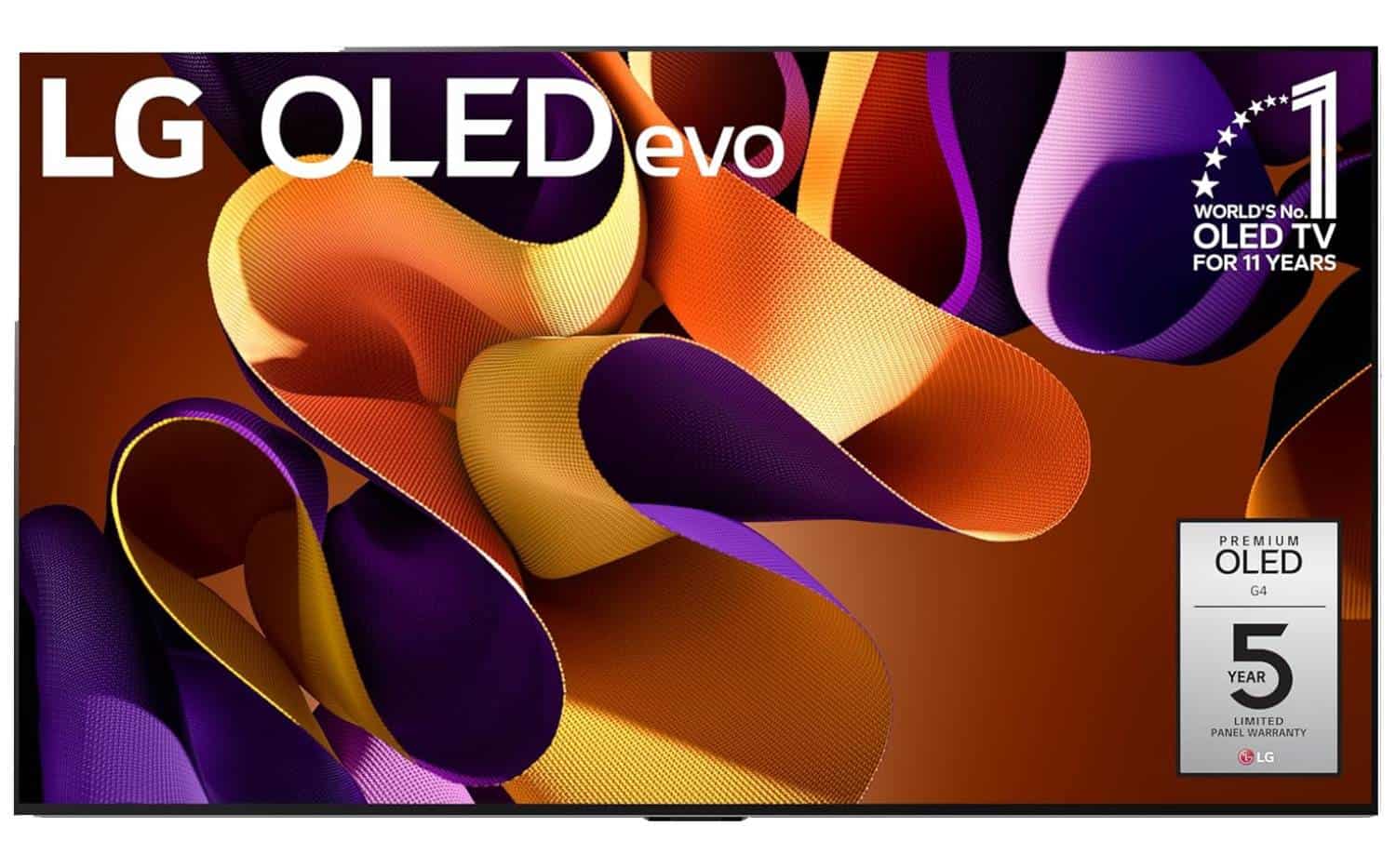
LG G4 OLED Series

Bright second-gen MLA OLED panel
Up to 144Hz, ideal for gaming PCs
Rapid responsiveness
Upgraded Alpha 11 AI Chip
MLA now available in 83″ model too
Expensive
Still no MLA in 97″ model
Time to compare LG G1 vs LG G4, how far has the OLED TV come?

WePC is reader-supported. When you buy through links on our site, we may earn an affiliate commission. Prices subject to change. Learn more
The LG G-series TVs are some of the best OLED TVs the company has ever made. They offer top-notch features, a brilliant display, and a remarkably immersive audio system. In this guide, we will be comparing the LG G4 vs G1 to see how much LG has improved over the past years, and whether it’s time for you to upgrade. In similar fashion, we’ve also compared LG G4 vs LG G2 if you’re interested.
Coming with the 2nd gen Micro Lens Array (MLA) OLED panels, the LG G4 gets a significant boost in both SDR and HDR brightness. Similarly, the LG G1 was the first to introduce OLED evo panels, which, at the time, also brought a massive peak brightness boost over the LG GX (2020).
The G-series has always been equipped with high-end gaming features, and that includes an HDMI 2.1 interface, high refresh rate, and low response time to make them the best gaming TVs at the premium level. Now then, let’s go into more detail to see how much of an improvement the 2024 LG G4 is over the G1.


Bright second-gen MLA OLED panel
Up to 144Hz, ideal for gaming PCs
Rapid responsiveness
Upgraded Alpha 11 AI Chip
MLA now available in 83″ model too
Expensive
Still no MLA in 97″ model

Evo OLED panel
120Hz refresh rate
4K screen resolution
HDMI 2.1 support
VRR technology
Dolby Atmos
Only three sizes
Shop on Amazon
CHECK PRICE| Specification | LG G4 | LG G1 |
|---|---|---|
| Panel type | OLED evo (2nd-gen MLA) | OLED evo |
| Size range | 55″, 65″, 77″, 83″, 97″ | 55″, 65″, 77″ |
| Resolution | 3840 x 2160 (4K) | 3840 x 2160 (4K) |
| Refresh rate | 144Hz | 120Hz |
| Processor | Alpha 11 AI | Alpha 9 AI |
| HDMI standard | 4x HDMI 2.1 | 4x HDMI 2.1 |
| VRR | HDMI VRR, AMD FreeSync, NVIDIA G-Sync | HDMI VRR, AMD FreeSync, NVIDIA G-Sync |
| Audio | AI Sound Pro, DTS:X, Wireless lossless Dolby Atmos | AI Sound Pro, Dolby Atmos |
LG has been quite busy making massive improvements in every department. No matter which aspect you compare, the G4 is miles ahead of the G1. But most of its improvements are thanks to the improved MLA OLED panel. Sure, both TVs are OLED, so they benefit from the infinite color contrast and deep blacks, but the Micro Lens Array tech makes the G4 ridiculously brighter, all while maintaining the same premium picture quality with vibrant colors.
Just like the display, a TV is as good as its sound quality, and the same story follows here as well, in certain regards at least. Both TVs have AI Sound Pro and Dolby Atmos, but the Alpha 11 AI chip on the G4 delivers a virtual 11.1.2 up-mix compared to the G1’s 9.1.2 that takes things to the next level. Along with that, the overall sound quality of the G4 is should be punchier with clearer dialogue. That being said, we’d always recommend picking up the best soundbar for TV, as this will be much better than the TV’s speakers alone.
The G4 also comes in massive sizes like 83” and 97”, so if you planning to upgrade to a bigger screen, the G4 gets another point. But it should be mentioned that the 97” does not use the MLA panel.
Moving on to processing power and responsiveness, the G4 again leaves the G1 in the dust. Its latest Alpha 11 AI chip is significantly faster than the 3-year-old Alpha 9 AI chip. As such, the controls and responsiveness of the G4 are unmatched. The Alpha 11 AI is also one of the main reasons why the G4 looks and sounds superior.
| Size | LG G4 | LG G1 |
|---|---|---|
| 97” | $24,999.99 | N/A |
| 83” | $6,499.99 | N/A |
| 77” | $4,599.99 | $4,499.99 |
| 65” | $3,399.99 | $2,999.99 |
| 55” | $2,600.00 | $2,199.99 |
Given that the LG G1 has been out for several years, it is no surprise that the TV costs significantly less than their G4 alternatives these days as it has dropped well below the original MSRP listed above. Of the three G1 sizes, only two are available at the moment on Amazon (65” and 77”) and both of them cost way less than the G4 ($1,400 and $2,100, respectively at the time of writing).
However, we would still not recommend going with the G1, it is still a rather outdated TV, and spending extra bucks with the G4 is totally worth it. Plus, as we approach deals season like Prime Day, Black Friday, and Cyber Monday, the G4 will be sold at a discount, whereas the G1 is becoming harder to find in new condition. Looking back to the G3 is an alternative as well.
The LG G1 was an excellent gaming TV of its time, but the LG G4 takes the throne with its improved features and fast response times. For starters, the G4 can refresh at up to 144Hz, while the G1 can only get to 120Hz. Plus, the response time of the G4 is simply unparalleled at <0.1ms, the TV, put simply, is super fast. You feel zero lag and the games look as smooth as possible.
Both TVs have 4x HDMI 2.1 ports and support for VRR, which is good. But the HDR quality of the LG G4 gives it an edge in HDR gaming as well. Of course, the improved MLA panel plays a role in gaming, as the G4 boasts better HDR visuals and viewing angles as well.
In short, if you play fast-paced games, the LG G4 is on another level. From display to sound, from high refresh rate to low response time, the TV has got it all. The G1 isn’t too far behind in terms of gaming features, though the lower refresh rate and worse panel in general are two key differences.


Sizes
55″, 65″, 77″, 83″, 97″
Screen technology
OLED
Resolution
3840 x 2160 (4K)
Refresh rate
144Hz
Panel type
WOLED (MLA)
HDMI standard
HDMI 2.1

Sizes
55″, 65″, 77″
Screen Technology
OLED Evo
Resolution
4K Ultra HD 3840 x 2160p
Refresh rate
120 Hz
Panel type
WOLED
HDMI standard
HDMI 2.1
If you’ve already got an LG G1 OLED TV living at the heart of your entertainment hub, we’d like to assume that you’re more than happy with what it offers. Even though the G4 does indeed make some big improvements, that doesn’t make the G1 a waste of space.
That being said, the G4 offers much better viewing during the day and in a well-lit room thanks to the advancements in panel technology, particularly peak brightness levels with MLA. This is the driving force to upgrade in our opinion, and if you aren’t always going to use your TV in a darker room, then it certainly warrants an upgrade if your G1 doesn’t cut it any longer.
As mentioned in our introduction, MLA stands for Micro Lens Array. This technology is a hardware-based change that LG have introduced, starting with the G3. The G4 now implements it for all models aside from the largest 97″ size. Thanks to a thin layer of microscopic lenses on the OLED panel, more light can be bounced and redirected towards the viewer to achieve improved luminance.
The G1 does use the brand’s OLED evo panel to make it brighter than the generation that came before it, and indeed the mid-range C1, but MLA takes it to a new level. For example, compared to the regular OLED panel on the entry-level B4, the second-gen MLA is up to 150% brighter according to the LG store page.
Overall, our crown goes to the LG G4. It is a superior option in every aspect, and it is very apparent just by looking at the TV, not that this should come as a surprise to anyone. It is going to be one of the best TVs of 2024, and given its extensive features, it will last you for several years to come. Check out our where to buy LG G4 guide to find one in stock.
On the other hand, the LG G1 is already an outdated option if you’re looking to buy, and you’ll be missing out on many great features. The only reason to go with the G1 is if you want a massive 77” screen for a fraction of the price. However, it still holds up in most cases if you’ve already got one.